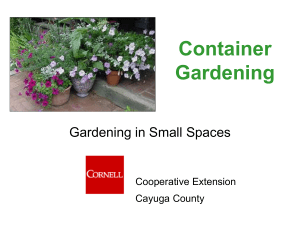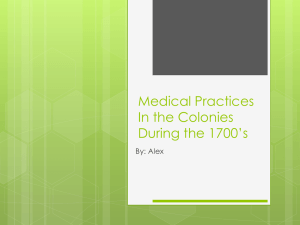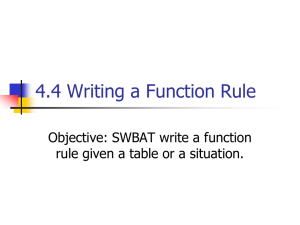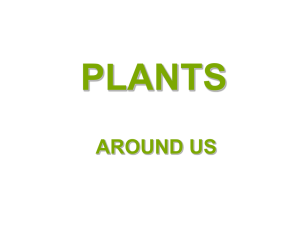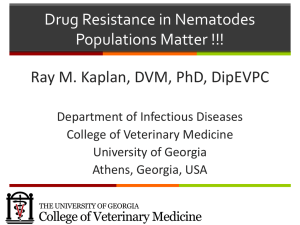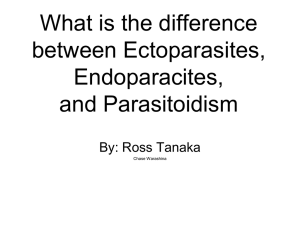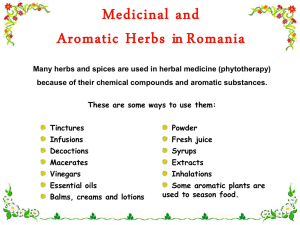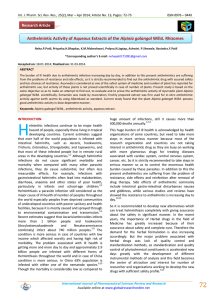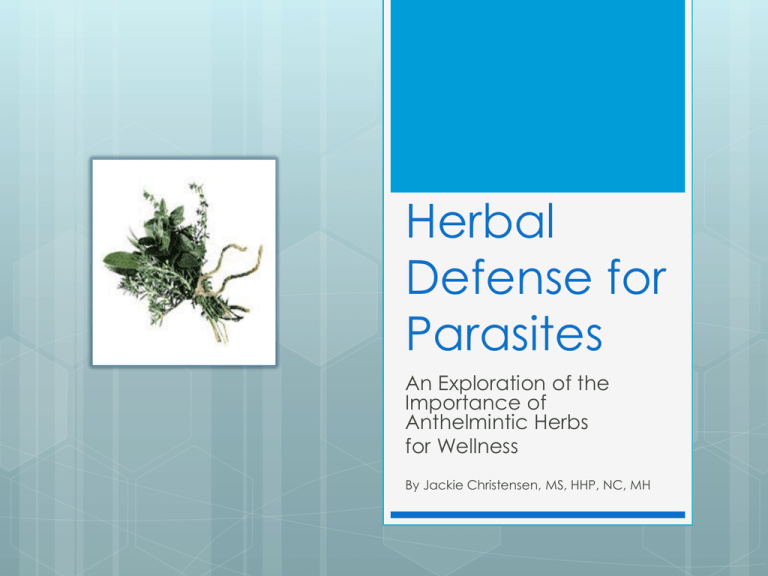
Herbal
Defense for
Parasites
An Exploration of the
Importance of
Anthelmintic Herbs
for Wellness
By Jackie Christensen, MS, HHP, NC, MH
Parasites-The Unwanted
Guests
Medical research has estimated that 85-95%
of the North American adult population is
infected with at least one form of parasite.
Humans can play host to over 100 different
kinds of parasites, ranging from microscopic
ones to tapeworms that can grow to be
several feet long.
Parasites are most frequently found in the
colon, but can also reside in other parts of the
body, such as the liver, lungs, muscles, joints,
skin, blood, and even the brain.
Common Sources of Parasite Infection
Under
cooked meats (beef, pork and raw
fish, especially)
unwashed fruits and vegetables
travel to third-world countries
contaminated water
mosquitoes
pets
walking barefoot outdoors
Symptoms of Parasite Infection
Bloated abdomen
Inability to lose weight
Dark circles around or under
the eyes
Diarrhea or chronic
constipation or a
combination of both
Persistent acne and skin
eruptions
Teeth grinding
Insomnia (especially waking
between 2-3 a.m.)
Cravings for sweets
Moodiness
Depression
Chronic fatigue
Anemia
PMS
Bad breath
Bad body odor
Food allergies
Sinus congestion
Constant abdominal
discomfort
Digestive problems
Anal itching
Water retention
Physical Effects of Parasites
Deteriorate the immune system, making the
body more vulnerable to infections.
Consume the most nutritious part of our diet
and nutrients.
Irritate the tissues of the body, causing
inflammation.
Produce toxic waste products into the body.
Destroy cells faster than the body can
reproduce them, leading to an imbalance.
Damage the intestinal lining.
Obstruct the intestine and pancreatic bile
ducts.
Anthelmitic Herbs Defined
The
anthelmitic herbal category includes
herbs that kill or expel parasites from the
body. It is a blanket term for both
vermicides and verifuges.
Vermicides:
herbs that kill parasites
Vermifuges: herbs that expel parasites
Note: Anthelmintic herbs should be used
with purgatives to help expel parasites from
the body.
Dietary Considerations &
Cleansing
Parasites thrive in an environment that is
created by too much sugar and processed
foods, therefore it is important to avoid
sweets, sugar, juices, fruit, greasy foods and
white flour if a parasite is assumed.
Fecal buildup on the walls of the colon
provide an ideal atmosphere for parasites, so
colon cleansing is recommended along with
herbal therapy.
Dietary Considerations &
Cleansing
Fasting
is recommended during
treatment.
It is recommended to cleanse around
a full moon because that is when
parasites are more active.
Consuming 2-3 tablespoons of
uncooked brown rice first thing in the
a.m. is a remedy that has been used
in the treatment and prevention of
parasites.
Common Human Parasites
Hookworm
A parasitic nematode worm that
originates externally, but can be
transmitted internally via contaminated
water, unwashed fruits and vegetables.
Once inside the body the hookworm
larvae attach to the wall of the intestine
and consume the host’s blood.
Symptoms: weakness, abdominal pain,
nausea, diarrhea, anemia
1.
Human Parasites Continued
2. Roundworm
Largest nematode known to affect the intestinal
tract.
May grow to be as large as 15-35 centimeters .
Transferred through consumption of unsanitary
food or water.
Eggs hatch, pierce the intestinal wall, enter the
blood stream and relocate to the lungs. Where
they are expelled via coughing, if swallowed they
may reenter the digestive tract.
Symptoms: fever, lethargy, rash, vomiting,
diarrhea, nerve problems, difficulty breathing,
coughing
Human Parasites Continued
3. Flatworm blood fluke
The flukes live in the blood stream and
infiltrate the people who come into contact
with the tainted water.
They live in the bloodstream of the host.
Cause inflammation of internal organs,
notably the liver.
May reside in the host for years without any
signs of symptoms.
May be excreted in the feces.
Symptoms: fever, aching, cough, diarrhea,
swollen glands, lethargy
Human Parasites Continued
4. Tapeworm
Some common varieties tapeworms include beef
tapeworm, bladderworm, pork tapeworm, broad fish
tapeworm, dog tapeworm, dwarf tapeworm and rat
tapeworm.
Cattle and pigs consume tapeworms through
contaminated fecal matter and are transmitted to humans
upon consumption of the animals.
The tapeworm has a hook on its head which it uses to
attach itself to the host’s intestine.
Within 3-4 months the tapeworm will mature and start to
reproduce.
They can survive for up to 25 years in a host.
Symptoms: nausea, vomiting, inflammation of the intestine,
diarrhea, weight loss, dizziness, fits, malnutrition
Human Parasites Continued
5. Pinworms
Common human parasite.
Named from their long pin shaped body.
Live in the host’s intestinal tract, but do not
enter the bloodstream.
They lay their eggs outside the human body,
more often at night, which causes intense
rectal itching.
Scratching the area can encourage the
larvae's spread via hand contact.
Symptoms: rectal irritation and irritation
Human Parasites Continued
6. Whipworm
Gets its name from the characteristic whip-like
shape.
Reside in the large intestine and insert their
anterior end into the intestinal lining.
Worms can live for several years.
Heavy infections in children can cause
mental and physical retardation.
Diagnosis can be determined by appearance
of eggs in the feces.
Typically asymptomatic, but symptoms may
occur in heavy infections.
Symptoms: diarrhea, dysentery, and anemia
Human Parasites Continued
7. Lymphatic Filariasis
Adult parasites live in the lymph nodes of humans.
Contamination is transmitted via infected
mosquito.
Causes “elephantiasis”
Repeated infections can result in blockage of the
lymph nodes and ducts, which results in swelling of
the tissues.
The adult parasites generally prefer the lymph
nodes that drain the lower abdominal cavity and
legs, so “elephantiasis” is often marked by
disfigurations of the external genitals and legs.
Symptoms: swollen lymph nodes
Actions of Anthelmintic Herbs
Vermifuges:
cause worms to expulse from
the body
Vermicides: destroys worms in the body
Taeniafuges: expels tapeworms from the
body
Taenicides: kills tapeworms from the body
Anthelmintic Herbs
1. Wormwood
Part used: herb, oil
Actions: tonic, anthelmintic, stomachic,
stimulant, febrifuge, hepatic, aromatic,
antiseptic, nervine, anti-venomous,
carminative
Common Preparations: fluid extract,
infusion oil, powders, tinctures
For roundworms take 2 ounces to 1 teacup
of an infusion in the evening and morning.
Wormwood Formulas
Dr. Shook’s Anthelmintic Vermifuges
½ ounce wormwood
½ ounce tansy
½ ounce satonica
½ ounce chamomile flowers
Instructions: Boil 1 quart of water and pour
over herbs and cover for 2-3 minutes, strain
and keep in a dark cool place.
Dosage: 1-2 ounces, 2 times daily
1.
Wormwood Formulas
2. Round worm formula
1 ounce wormwood
1 ounce rue
1 ounce peach leaves
Instructions: Pour one quart of boiling water
over the herbs and steep for 1 hour, strain
and bottle. Infusion may be sweetened if
preferred.
Dosage: 6 ounces, 3-4 times daily on an
empty stomach
Anthelmintic Herbs
2. Pumpkin seeds
Parts used: ripe seeds, the fresher the better
Actions: anthelmintic, diuretic, nutritive
Uses: tapeworms, round worms, renal issues
Common preparations: decoction,
crushed seeds. To make a decoction, boil
one ounce of seeds in one pint of water for
15-20 minutes.
Dosage: up to one pint daily
Pumpkin Seed Formula
1.
Four Great Cold Seeds Remedy
1 part pumpkin seeds, crushed
1 part ground seeds, crushed
1 part watermelon seeds, crushed
1 part cucumber seeds, crushed
Instructions: Triturate with water into an
emulsion
Dosage: 6 ounces, 3-4 times daily
Anthelmintic Herbs
3. Kousso
Parts used: fresh or dried flowers
Actions: anthelmintic, cathartic, astringent
Uses: tape worms
Common Preparations: fluid extracts,
infusion, powder
Dosage: 1-4 teaspoons, works more
effectively while fasting and drinking lemon
juice before and after the dosage.
Kousso Formula
Anthelmintic Infusion of Kuosso
¾ ounce kousso flowers
1 pint of purified water
Instructions: Boil the water and pour over
the herb, steep covered for 10 minutes, do
not strain, stir well
Dosage: drink the entire mixture is 3 doses,
10 minutes apart
Anthelmintic Herbs
4. Tansy
Parts used: herb, seed
Actions: anthelmintic, tonic, emmenagogue,
diaphoretic, stimulant, diuretic, nervine,
vulnerary, carminative
Uses: expels worms, also good for menstrual
issues
Common Preparations: decoction, infusion,
tincture
Dosage: 3-6 ounces of an infusion at night and
in the morning
Tansy Formula
Potter’s Vermifuge
1 part tansy herb or seed
1 part wormwood herb
1 part santonica
1 part chamomile flowers
Instructions: steep herbs one teaspoon of
herbal combination in a tightly covered pot
with 6 ounces of water for 10-15 minutes.
Dosage: 2 ounces, 3 times daily
1.
Anthelmintic Herbs
5. Hyssop
Parts used: herb
Actions: anthelmintic, diuretic, diaphoretic,
stimulant, expectorant, carminative,
vulnerary, pectoral, febrifuge, aromatic
Uses: expelling worms, sore throat,
inflammation, colds, coughs
Common Preparations: fluid extracts,
powder, tincture
Dosage: ½-2 teaspoons fluid extract
Anthelmintic Herbs
6. Pink root
Parts used: root, herb
Actions: anthelmintic, commonly combined
with senna for its purgative effect
Uses: tape worms and round worms
Common Preparations: infusions, powders,
tinctures, extracts
Dosage: ½-1 teaspoon for tincture, ½ -1
teaspoon for powders
Pink Root Formula
1.
Pink Root Anthelmintic Powder for
Children
2 teaspoons pink root powder
2 teaspoons American wormseed, powder
1.3 grams Cascara sagrada, powder
Instructions: mix powders and divide into
12 equal servings
Dosage: 1 dose 3-4 times daily for children,
can be mixed with stevia or a sugar-free
juice
Anthelmintic Herbs
7. Pomegranate
Parts used: bark, root bark, peel of fruit
Actions: anthelmintic, astringent
Uses: kills and expels tape worms and round
worms. The root bark is the most potent
anthelmintic portion of the herb. The fruit is
considered to be a blood tonic
Common Preparations: standard
decoction
Dosage: up to one pint daily
Pomegranate Formula
Anthelmintic Decoction
4 ounces pomegranate root bark, cut
3 pints distilled water
1.
Instructions: Simmer the herb in water for
one hour, strain, and simmer the liquid until
reduced to 1 pint
Dosage: 3-4 ounces every 4 hours
Resources
Christopher , J. (2009). School of Natural Healing . (14th
ed.). Springville, UT: Christopher Publications .
Frawley, D., & Lad, V. (1988). The Yoga of Herbs: An
ayurvedic guide to herbal medicine. (2nd ed.). Twin Lakes,
WI: Lotus Press.
Tierra, M. (1998). The Way of Chinese Herbs. New York, NY:
Pocket Book.
Tierra, M. (1988). Planetary Herbology. (1st ed.). Twin Lakes,
WI: Lotus Press.
Tierra, M. (1998). The Way of Herbs. (1st ed.). New York, New
York: Pocket Book.
The enemy within: 10 human parasites. (2009, July). New
Scientist. Retrieved May 10, 2012, from
http://www.newscientist.com/gallery/mg20327161300enemy-within-human-parasites/11
The Global College of Natural Medicine (2010). Toxicity and
Detoxification. Holistic Health Practitioner Module 1


